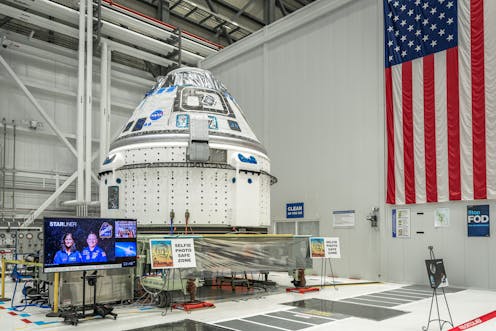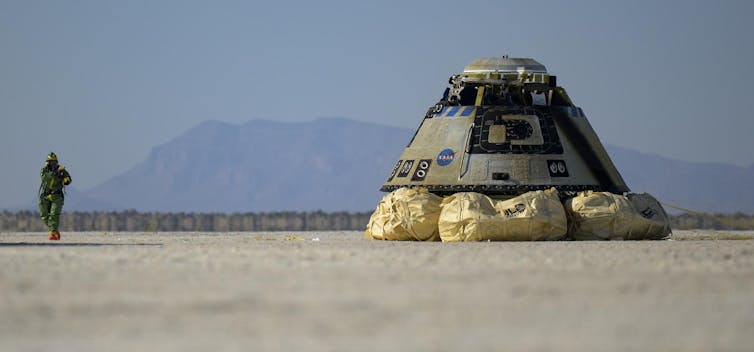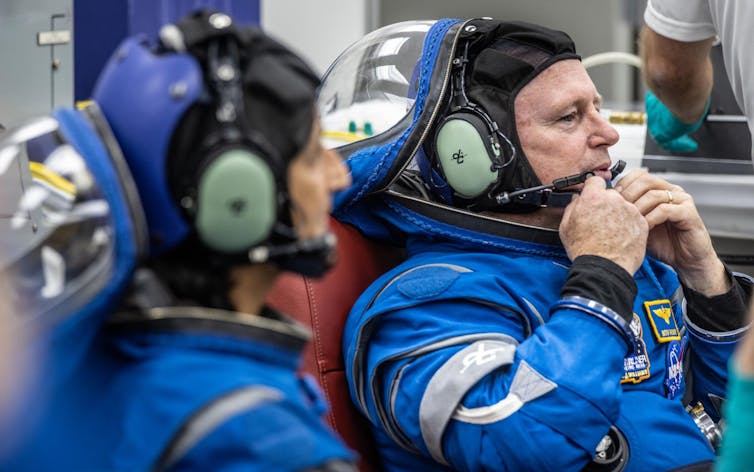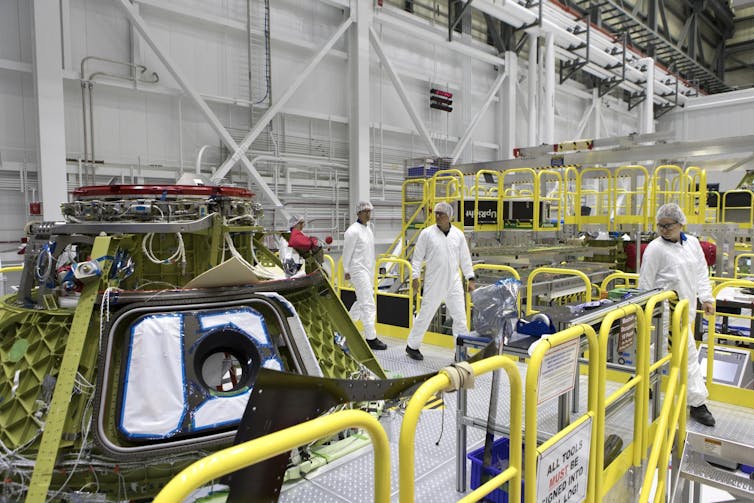Starliner: Boeing prepares to launch its first crewed spacecraft as it chases after SpaceX

Boeing’s CST-100 Starliner is scheduled to make its first flight into space with astronauts on May 6, 2024. This flight and a few others will take place take under contract with Nasa, as part of a programme to transport astronauts from Earth to the International Space Station (ISS) and back.
Following years of delays, a successful flight would provide the United States with a second operational spacecraft to carry astronauts to low-Earth orbit, after SpaceX’s Crew Dragon.
Having two different spacecraft available provides a back-up option if something should go wrong with one of them. So it will secure access to space for astronauts from American soil. While Starliner will be flying to the ISS for now, it could eventually make trips to future commercial space stations, like that being built by Houston-based company Axiom Space.
Getting to space has never been easy, however. In the case of Starliner, that is something of an understatement. The project began back in 2010 as part of Nasa’s Commercial Crew Program (CCP) when Boeing, along with SpaceX, and Sierra Nevada, was selected to develop spacecraft that could provide access to low-Earth orbit and the ISS.
The CCP design requirements were that the spacecraft had to be capable of ferrying at least four astronauts safely to and back from the ISS, to remain docked there for at least 210 days, and to provide at least 24 hours of life support in the event of an emergency return to Earth from orbit.
However, the project has been beset with delays, including supply chain issues, and the COVID-19 pandemic. The original contract was intended to certify Starliner for orbital operations with astronauts in 2017. However, the first orbital flight test, without astronauts, did not occur until 20 December, 2019.

It was intended to be an eight-day mission in which the spacecraft would rendezvous with the ISS and dock, before returning to Earth. During the flight, the spacecraft’s onboard clock suffered a technical malfunction, which caused the rocket engines to fire – manoeuvring the craft into the wrong orbit. It failed to reach the ISS and returned to Earth after only two days.
After lengthy investigations and technical fixes, Boeing agreed to re-run the un-crewed flight test at its own expense. Orbital Flight Test 2 launched on May 19, 2022 – two years after SpaceX’s Crew Dragon had made its first successful crewed flight to the ISS. This time, Starliner’s flight was successful. The spacecraft reached the ISS and docked on 21 May, 2022, where it stayed for four days, before making a safe return to Earth.
In the meantime, SpaceX has managed to launch nine flights to the ISS carrying astronauts and four commercial flights carrying a mixture of civilians and astronauts from other countries. The flight on May 6 will carry two experienced Nasa astronauts aboard. They are Sunita “Suni” Williams and Butch Wilmore. Both have flown on both the space shuttle and the Russian Soyuz spacecraft.
New suits
They’ll wear distinctive blue flight suits which, unlike most previous designs, feature a flexible hood rather than a solid one. The lightweight materials permit the astronauts to perform delicate tasks such as using a tablet despite having gloved hands.
Flight suits are designed only to be worn inside the pressurised environment of the spacecraft, not outside, and only during ascent to and return from orbit. However, they provide protection and life support to the astronauts if the capsule depressurises during these most hazardous phases of the flight.

The combination of greater mobility, lighter weight and better dexterity, as well as a very wide field-of-view out of the hood visor, has made these suits quite popular with the astronauts who have tested them.
Starliner itself is comprised of the crew capsule and a service module. The crew capsule is the part that carries people and is made of an aluminium alloy. It can accommodate up to seven astronauts, or four astronauts with up to 100kg of cargo.
The crew capsule is reusable, meaning it can be sent back into space after completing a mission, and is designed to make at least 10 flights into orbit. One innovative design feature of the spacecraft is the absence of welded sections. The crew capsule is comprised of two sections which are bolted together, rather than welded, in order to improve structural strength.
The service module houses the electrical power systems, and four Rocketdyne rocket engines. These are designed to rapidly separate the spacecraft from the Atlas V launch rocket in the event of an emergency during the ascent into space. They’re also used for manoeuvring the spacecraft once it reaches orbit.
Once in orbit, Starliner is capable of making a completely automated flight to, and docking with, the ISS, without any intervention from astronauts on board. However, astronauts can still take manual control of the spacecraft if necessary. Once at ISS, Starliner is designed to remain docked at the station for up to seven months.

When it is time to return to Earth, the crew will get back in Starliner and detach from the ISS. Just prior to atmospheric entry, the service module is detached and discarded. The crew capsule then uses a combination of heat shields and parachutes to slow its speed, before touching down on land. The landing is softened for the crew by the use of airbags.
This differs from the mode of return used by Nasa’s Orion spacecraft, which will be used to visit the Moon, and SpaceX’s Crew Dragon, both of which splash down at sea. By returning to land, Starliner removes the need to deploy specialist ships to sea in order to recover the spacecraft.
Despite the delays, Starliner looks to be a very capable modern spacecraft, which should provide the US with a second means of reaching the ISS and any commercial successors for years to come. There’s a lot riding on a successful performance on May 6.
Gareth Dorrian does not work for, consult, own shares in or receive funding from any company or organisation that would benefit from this article, and has disclosed no relevant affiliations beyond their academic appointment.


